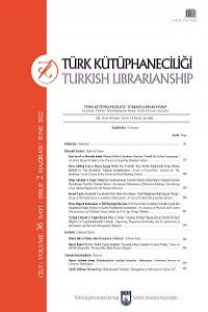Karolenj Rönesansı Bağlamında Kütüphaneler, Manastırlar ve Karolenj El Yazmaları
Charlemagne, Karolenj Rönesansı, Karolenj minüskülü, Karolenj el yazmaları, Kitap istinsahı
Libraries, Monasteries and Carolingian Manuscripts in the Context of the Carolingian Renaissance
Charlemagne, Carolingian renaissance, Carolingian minuscule, Carolingian illuminated manuscripts, manuscript production,
___
- Avrin, L. (2010). Scribes, script, and books: the book arts from antiquity to the renaissance. Chicago: American Library Association.
- Butt, J. (2002). Daily life in the age of Charlemagne. Connecticut: Greenwood Publishing Group.
- Claster, J. N. (1982). The Medieval experience, 300-1400. New York and London: NYU Press.
- Fichtenau, H. (1978). The Carolingian empire. (Cilt 1). Toronto, Buffalo, London: University of Toronto Press.
- Frassetto, M. (2013). Encyclopedia ofbBarbarian Europe: Society in transformation. California, Colorado, Oxford: Abc-clio.
- Genç, Ö. (2013). Birleşik Avrupa'nın mimarı Şarlman ve Karolenj Rönesansı. Ankara: Lotus Yayınevi.
- Halfond, G. (2010). The archaeology of Frankish church councils, AD 511-768. Leiden, Boston: Brill.
- Hen, Y. (1995). Culture and religion in Merovingian Gaul: AD 481-751. (Cilt 1). Leiden, New York, Köln: Brill.
- Hildebrandt, M. (1992). The external school in Carolingian society. (Cilt 1). Leiden, New York, Köln: Brill.
- Le Goff, J. (2006). Ortaçağ’da entelektüeller, (Çev. M. A. Kılıçbay). İstanbul: Ayrıntı Yayınları.
- Loveluck, C. (2013). Northwest Europe in the early middle ages, c. AD 600–1150: A Comparative Archaeology. Cambridge: Cambridge University Press.
- McKitterick, R. (1989). The Carolingians and the written word. Cambridge: Cambridge University Press.
- McKitterick, R. (2004). History and memory in the Carolingian world. Cambridge: Cambridge University Press.
- Painter, W.E. (1850). The seventh general council, the second of Nicaea, Held AD 787, in which the worship of Images was established: with copious notes from the “Caroline Books", compiled by order of Charlemagne for Its confutation. London: William Edward Painter.
- Rowling, M. (1973). Life in medieval times. New York: Perigee Book.
- Ullman, B. L. (1980). Ancient writing and its influence. (Cilt 10). Toronto, Buffalo, London: University of Toronto Press.
- Yayın Aralığı: 4
- Başlangıç: 1952
- Yayıncı: Türk Kütüphaneciler Derneği
Çin Halk Cumhuriyeti’nde Sovyet Revizyonizmi’ne Karşı Kitapların Propaganda Amaçlı Kullanımı
Mehmet Sezai TÜRK, Özkan AVCI, Tuğba BAYTİMUR
Karolenj Rönesansı Bağlamında Kütüphaneler, Manastırlar ve Karolenj El Yazmaları
Semanur ÖZTEMİZ, Mustafa Agah TEKİNDAL
Batman Şehit Şenay Aybüke Yalçın İl Halk Kütüphanesi
Derya ALAPALA, Mehmet Emin YILMAZ
Okuma Üzerine Sanat Temelli Boylamsal Bir Araştırma: İlkokul Öğrencileri Okurken Nasıl Hissediyor?
Biblioburro: Kolombiya’da Eşekli Kütüphane Girişimi
Akademisyenlerin Akademik Sosyal Ağlara Yönelik Tutumları: Ankara Üniversitesi Örneği
Demet IŞIK, Özlem GÖKKURT DEMİRTEL
İsmail Kutluay Kardeşimize Rahmetle
